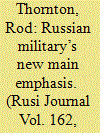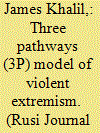| Srl | Item |
| 1 |
ID:
155727


|
|
|
|
|
| Summary/Abstract |
With Initial Operating Capability (IOC) declared by the US Marine Corps and US Air Force, increasing production and delivery rates, and impressive performances in recent exercises, the F-35 programme and the fifth-generation capability that it represents look to have turned a corner. As the capability moves towards Full Operating Capability (FOC), the debate, so long focused on costs, delays and technical issues, should now begin to be framed in new terms. André Adamson and Matthew Snyder analyse some of the stakes involved as the capability increasingly acts as a driver for fifth-generation transformation, and to consider some of the implications for air forces that have committed to the programme and, perhaps more significantly, for those that have not.
|
|
|
|
|
|
|
|
|
|
|
|
|
|
|
|
| 2 |
ID:
155706


|
|
|
|
|
| Summary/Abstract |
More than 20 years of Sino-Japanese cooperation and China’s efforts – such as its national implementation mechanism – to deal with the legacy of abandoned chemical weapons have resulted in great progress, and have been essential to the disposal of weapons. In this article, Wanglai Gao discusses how the Chinese experience has shown that the best way to deal with the legacy of abandoned chemical weapons is to cooperate with the former enemy and remedy the past by investing for the future.
|
|
|
|
|
|
|
|
|
|
|
|
|
|
|
|
| 3 |
ID:
155703


|
|
|
|
|
| Summary/Abstract |
Japan’s use and storage of chemical weapons in the Second World War is a relatively unknown aspect of the conflict. Jeanne Guillemin explores the legacy of this issue and reflects on Beijing and Tokyo’s joint efforts to manage the abandoned weapons still present in China.
|
|
|
|
|
|
|
|
|
|
|
|
|
|
|
|
| 4 |
ID:
155713


|
|
|
|
|
| Summary/Abstract |
Russia’s application of a sophisticated hybrid strategy and the rise of Daesh (also known as the Islamic State of Iraq and Syria, ISIS) have been drivers for change in the complex security environment of the twenty-first century. While the significance of these threats does not preclude the conventional aspect of national defence planning, it does complicate societal preparedness. Vlasta Zekulić, Christopher Godwin and Jennifer Cole examine the relevance of NATO resilience policies and propose a synchronised approach to crisis decision-making, civil preparedness planning and national and collective defence to ensure they are balanced, mutually supportive and incur manageable cost.
|
|
|
|
|
|
|
|
|
|
|
|
|
|
|
|
| 5 |
ID:
155723


|
|
|
|
|
| Summary/Abstract |
The fighter-bomber rose from obscurity in January 1941 to become the major component of the RAF’s Desert Air Force strike power by late 1942. This was a major shift in the way the RAF employed its aircraft. The tactical and technical factors that led to this change are crucial not only to understanding the course of the Second World War, but also to the history of airpower itself. In this article, Justin Bronk discusses how the fighter-bomber became the most important and practical component in the arsenal of a modern air force in terms of capability to project power on the battlefield.
|
|
|
|
|
|
|
|
|
|
|
|
|
|
|
|
| 6 |
ID:
155710


|
|
|
|
|
| Summary/Abstract |
The nature of the Russian military threat to Western interests needs to be reassessed. An examination of articles in Russian military journals shows that its senior ranks now see ‘asymmetric means and methods’ as their new ‘main emphasis’ in modern peer-state wars. Rod Thornton explains that for them, winning such wars through asymmetric means has become a key way to impose Moscow’s will on other states. Remarkably, they seek to avoid the use of military violence.
|
|
|
|
|
|
|
|
|
|
|
|
|
|
|
|
| 7 |
ID:
155717


|
|
|
|
|
| Summary/Abstract |
Prominent frameworks relating to terrorism and violent extremism, including that developed by the NYPD and the popular ‘pyramid’ and ‘staircase’ analogies, tend to oversimplify or neglect the diversity of routes that individuals travel to violence. The Three Pathways (3P) model developed by James Khalil contributes to theory, and provides an effective lens through which policymakers and implementers can evaluate their current and future preventive countermeasures under the countering and preventing violent extremism frameworks.
|
|
|
|
|
|
|
|
|
|
|
|
|
|
|
|